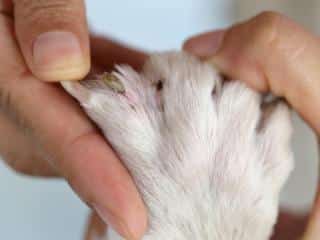

Ticks attach to your dog’s fur during outings in forests, parks, and garden. They are particularly active between 32°F and 68°F (between 0°C and 20°C). Ticks plant their rostrum on warm and moist parts of your pet’s skin to feed on blood. Through the tick’s bite, many severe and sometimes fatal diseases infect our pets.
Discover the danger ticks pose to dogs.
First of all, a tick is a few millimeters long. It’s a mite that’s part of the spider family. It feeds on blood at every stage of its life (larva, nymph, and adult). It needs water but can go without feeding for months (diapause).
Secondly, it has a “rostrum”. This is a mouthpiece that allows it to attach to its host (animal, human) to feed on its blood. At each stage of its life, it needs this blood to develop and survive.
Lastly, it carries viruses, parasites, and bacteria, which it transmits 12 to 48 hours after latching onto its host. The transmission of these pathogens is very serious for our dogs, and sometimes irreversible.

On hot-weather days, they stay close to the ground in search of water. This allows them to easily sneak into your pet’s fur. As a result, they pose a danger year-round for dogs, active and sedentary, urban and rural.
If you regularly inspect your dog’s fur, it is easy to spot an adult tick filled with blood. But in its larva or nymph stage, this isn’t as easy: it’s no bigger than a pinhead. Identifying it then becomes more difficult, but its bite is just as dangerous.
If you find a red, swollen bulge behind your dog’s ears, under the armpits, or in the groin, it may have been bitten by a tick. These are the lymph nodes of the dog’s immune system, and if they’re swollen it means the body is trying to fight off an infection. If there are additional symptoms such as lethargy, refusal to eat, and sudden limping, consult a vet quickly.

And less commonly, hepatozoonosis (tick ingestion) or transient paralysis, a reaction to toxins secreted by some ticks.
→ Learn more: prevention against ticks
Your pet’s cleanliness has no influence on ticks. They’ll hop on and bite it no matter how clean your dog is. So, to fight the danger ticks represent to your dog, regularly check your pet and protect it with suitable dog tick control throughout the year.
L.D.